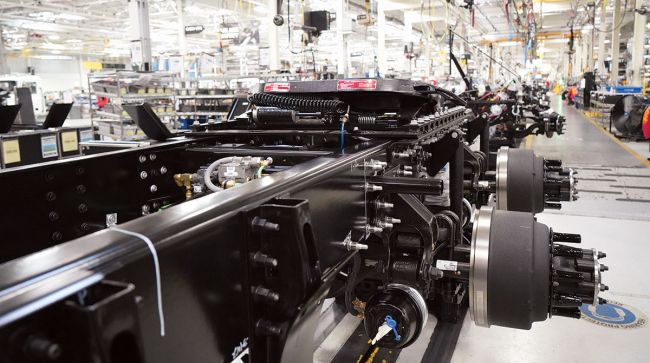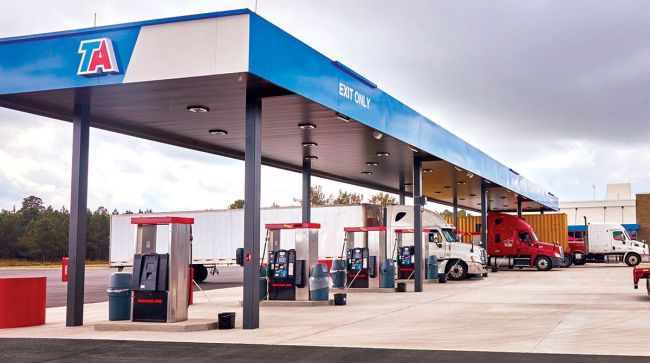Mack trucks in production at the Lehigh Valley Operations Plant in Macungie, Pa. Overall Class 8 orders in April fell 27% year-over-year, according to ACT Research data. (Mack Trucks)
North American Class 8 orders in April continued the trend of year-over-year declines by dropping to 11,600 units, ACT Research reported.
ACT preliminary data showed orders fell 27% compared with 2022, when they hit 15,800 units. The only month so far to see a year-over-year increase was February. Orders also were down 39% from the previous month at 19,200 units.
“Given robust Class 8 orders into year-end, ensuing backlog support and normal seasonal order patterns, orders were expected to moderate into Q2,” said Eric Crawford, vice president and senior analyst at ACT. “Coupling those items with increasingly cautious readings from the ACT Class 8 Dashboard, April orders were weaker than expected on a stand-alone basis.”
Crawford, however, noted that the seasonally adjusted year-to-date figure is squarely in line with expectations at 17,500 units. ACT expects seasonally adjusted orders to be in a range of 15,000 to 20,000 units per month until midway through the third quarter.

ACT Research Vice President and Senior Analyst Eric Crawford. (ACT Research)
“The recent turmoil in the banking sector likely tightened credit conditions for some industry participants and may have played a factor in exacerbating April’s weakness,” Crawford said. “Thus, while we expect orders to remain at subdued levels into mid-[third quarter], we are not inclined to think April’s order activity represents the likely run rate going forward.”
Truck orders closed out the latter part of last year strong , including an all-time high in September. But that started to change this year with new truck orders falling short of the year-ago figures for the most part.

Randall
“Preliminary HD sales numbers in April show a 25.4% improvement YTD over the same period in 2022,” said Jonathan Randall, president of Mack Trucks North America. “At Mack, we saw our overall market share improve and our YTD sales continues to be higher than the market’s growth rate. We remain confident in the level of demand we are seeing from our customers as market forces still support a need for new trucks.”
FTR, an economic and freight forecasting firm, noted in its preliminary data that Class 8 truck orders fell 20% year-over-year to 12,050 units from 15,066. It also recorded a 37% month-over-month decrease with 19,000 units being ordered for March.

Starks
“When 2024 order boards open later this year, we anticipate some modest additional strength in order activity,” FTR Chairman Eric Starks said. “There still are indications that fleets are requesting equipment, and there has been no notable uptick in cancellations. Once we see the full data midmonth, we will have a better grasp on any changes in cancellation behavior.”
Starks doesn’t anticipate much negative impact on production levels over the next few quarters despite the weakness. He noted the incoming order rate for March was 145,000 annualized, which is on par with the weak order levels during the summer of 2022. He also expects backlogs will have come down during April.

Chad Crotty of DDC FPO Solutions discusses how fleets handle outsourced business services. Tune in above or by going to RoadSigns.ttnews.com.
“We’re on allocation and we were on allocation last year as well,” Kenworth Sales Co. President Kyle Treadway said. “So those numbers in our experience have little or nothing to do with demand. They have everything to do with our ability as an industry to manufacture vehicles. So, a 27% year-over-year decrease under normal circumstances would be very alarming. But in this environment, I don’t take a lot of stock in it.”
Treadway added that while demand for trucks may be down, it still exceeds supply. He noted orders his company is taking are filled through the third quarter. Those slots are also close to being filled in the fourth quarter.
“We, as an industry, didn’t follow the typical pattern because of the allocation system the last couple of years,” Treadway said. “Normally we would have overproduced and oversold. We were not able to do that, so the peaks were not as high and the valleys will not be as low.”
Treadway noted the issues with production continue to be parts and components availability. The difference is what parts are unavailable keep changing. He noted the manufacturer would solve one issue only for another to arise.
“It continues to be those exact same issues, albeit they’re different,” Treadway said. “It’s the whack-a-mole game. You resolve one problem here, and then another one pops up over on the other side. And so, we continue to have supply constraints and component constraints.”
Treadway also noted that demand for trucks depends heavily on what market segments they operate in. He pointed to his energy industry and commercial construction customers as doing well. But residential construction has not been.
“We are seeing some hesitation in some of the market segments,” Treadway said. “Not all of them are experiencing the same declines. Some of them are still doing quite well.”





